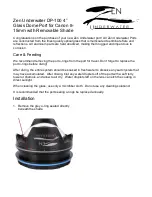
RCMR Pag. 44 Rev. 02 02 13
UK
2.
Referring to
Paragraph 4.5 – Dis-installation
in
Chapter 4 - Transport and Installation
, proceed to dis-install the
PARTLY COMPLETED
MACHINERY
; moreover, contact the Technical Offices of the Manufacturer to obtain the necessary assistance during this
intervention.
3.
To proceed to handle the
PARTLY COMPLETED MACHINERY
, operate in accordance with the instructions reported in
Paragraph 4.2 -
Transport and Handling
in
Chapter 4 - Transport and Installation
.
4.
Appropriately arrange the components based on whether they must be transported to another premise (refer to
Paragraph 4.2 -
Transport and Handling
in
Chapter 4 - Transport and Installation
), stored (refer to
Paragraph 4.4 - Storage
in
Chapter 4 -
Transport and Installation
) or be demolished (
Paragraph 5.4.2 – Demolition and Disposal
).
DANGER :
the Manufacturer rejects any responsibility for possible damages to things and/or persons
stemming from improper interventions performed by unqualified, untrained, inadequately
equipped, or unauthorized personnel.
5.5.2 Demolition and disposal
When the
PARTLY COMPLETED MACHINERY
has ended its life-cycle, before proceeding to its final dismantling, it is necessary to perform a
series of operations aimed at minimizing the environmental impact tied to the disposal of components of the
PARTLY COMPLETED
MACHINERY
, as required by the norms in force on waste disposal.
These operations are:
1.
Separate and stock the parts with environmental impact, in other words:
a.
separate the various parts that could be the cause of pollution;
b.
perform a selection of the materials in order to favor their recycling, reserving them for separate disposal (more specifically,
select the elements in plastic or rubber).
2.
The gas contained inside the system must not be disposed of in the environment. We recommend that you dispose of the
evaporator in specialized waste collection centers and not as standard iron junk, following the normative provisions in force.
3.
Dispose of the casings, in other words, once you have finished removing and stocking the pollutant elements, contact specialized
centers for the disposal of casings.
6
6
.
.
O
O
p
p
t
t
i
i
o
o
n
n
a
a
l
l
f
f
e
e
a
a
t
t
u
u
r
r
e
e
s
s
It is possible to have the following optional features installed on the
PARTLY COMPLETED MACHINERY
upon request by the customer.
UNIT VARNISHING
A varnished unit protects it against corrosive agents that may be present in the cell (e.g. code RCMR___-VT: grey epoxy powder
varnish). Other types of varnish must be specifically requested.
HEATER FOR THE DRAIN PIPE
It must be inserted inside the condensed water drain pipe, so that the water that has formed during the defrost does not freeze inside
the drain. It is used for applications on low-temperature cells and is manufactured to be powered with 220V. In case of a different
power supply, contact our Technical Office.
7
7
.
.
S
S
e
e
a
a
r
r
c
c
h
h
f
f
o
o
r
r
F
F
a
a
u
u
l
l
t
t
s
s
Problem
Possible cause
Solution
Evaporator frozen
Defrosting phase too short
Increase the defrosting time
Interval between two defrosts too long
Increase the defrosting cycles.
Check for any possible squashed pipes
Dripping time insufficient
Check the set dripping time
Air infiltration through the door, door opened too
often
Reduce door opening frequency and
eliminate any possible fissures
Electrical heaters burnt out
Replace the faulty heaters
Evaporator frozen only near the
thermostatic valve
Inflow of refrigerant to the evaporator is reduced Check sizing of thermostatic valve
Hole of thermostatic valve too small
Increase hole diameter
Excessive overheating
Check temperatures and act on valve
Evaporator damaged
Fins deformed
Straighten the fins with a comb
Fans blocked
Fan motor failure
Replace the fan motor
Line voltage lower than tolerance limits
Check value of voltage with voltmeter








































